NASA’s X-59 Quiet SuperSonic Technology (Quesst) aircraft has reached an important landmark in its developmental journey, as engineers at Lockheed Martin’s Skunk Works facility in Palmdale, California, successfully conducted its first engine test. This milestone, achieved in late October, is part of a series of phased tests aimed at assessing the aircraft’s performance and ensuring robust systems integration. While these engine assessments are crucial steps toward the aircraft’s maiden flight, an official date for take-off remains unannounced.
The testing process began with low-speed operations, allowing engineers to meticulously check for leaks and ensure that essential systems, such as hydraulics and electrical components, operated effectively with the engine in operation. These preliminary checks laid the groundwork for the full engine start-up, which served as a vital “warmup” phase to confirm that everything was functioning as intended, according to Jay Brandon, NASA’s X-59 chief engineer.
Innovative Design for Reduced Noise
At the heart of the X-59 is its modified F414-GE-100 engine, which is a variant of the powerplant used in the U.S. Navy’s Boeing F/A-18 Super Hornet. Unlike conventional supersonic jets that generate explosive sonic booms, the X-59 is designed to reach speeds of Mach 1.4 while producing a much more subdued sound profile, described as a mild “thump.” This aerodynamic innovation is made possible by the aircraft’s distinctive long, slender nose, extending over 11 meters in length, which strategically mitigates the disruptive noises typically associated with supersonic flight.
To better understand the sound characteristics of the X-59, NASA has drawn on data from F/A-18 jets to create simulations of its unique audio signature. The implications of this quieter sonic profile extend beyond engineering; they have the potential to influence regulations regarding supersonic flights over populated regions, opening the door to future commercial applications where conventional noise restrictions have traditionally posed significant barriers.
In a groundbreaking move, NASA unveiled the X-59’s innovative cockpit design in January 2024, notably devoid of a traditional forward-facing window. To compensate for this unconventional setup, the cockpit is equipped with an advanced “eXternal Vision System” that amalgamates various camera feeds and augmented reality to provide pilots with a comprehensive view of the aircraft’s surroundings. Pam Melroy, NASA’s Deputy Administrator, underscored the importance of this technology in addressing visibility challenges posed by the aircraft’s design.
The upcoming phases of testing will dive deeper into the X-59’s performance under various simulated scenarios. In addition to taxi tests aimed at ensuring smooth operations on the ground, the team is preparing for flight tests over selected U.S. cities. This initiative is designed to gauge public responses to the quieter sound emitted by the aircraft, integrating societal feedback into future noise regulations.
Through these efforts, NASA aims to collect invaluable data to substantiate the feasibility of quiet supersonic travel, paving the way for a new chapter in commercial aviation that prioritizes both speed and noise mitigation. The X-59’s advancements hold promise not only for improving flight technologies but also for fostering public acceptance and regulatory adjustments necessary for the evolution of supersonic air travel.

